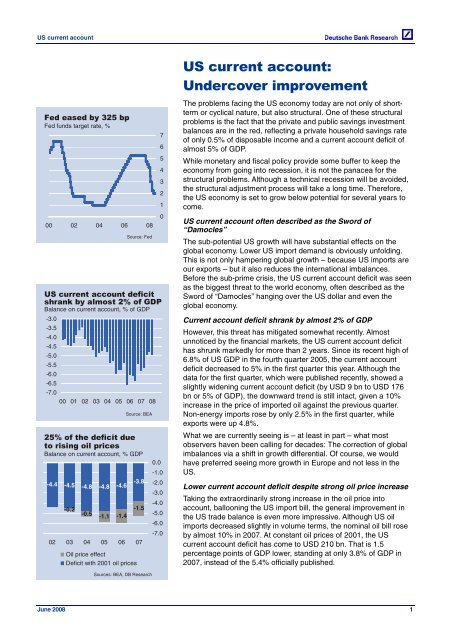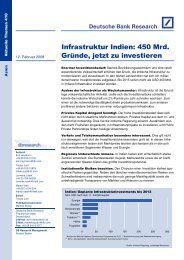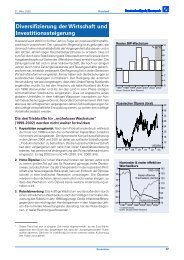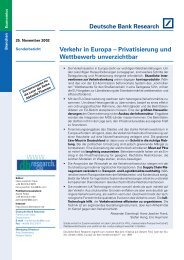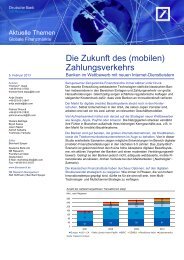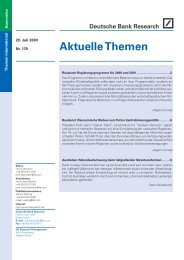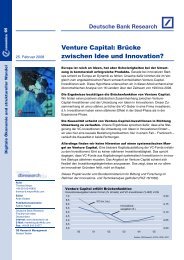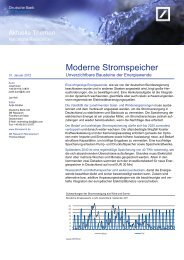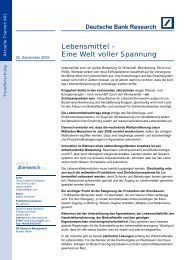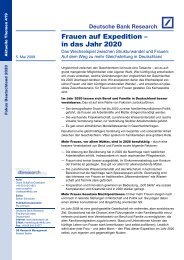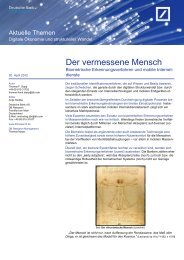Bernhard Gräf: US Current account: Undercover improvement
Bernhard Gräf: US Current account: Undercover improvement
Bernhard Gräf: US Current account: Undercover improvement
You also want an ePaper? Increase the reach of your titles
YUMPU automatically turns print PDFs into web optimized ePapers that Google loves.
<strong>US</strong> current <strong>account</strong><br />
Fed eased by 325 bp<br />
Fed funds target rate, %<br />
00 02 04 06 08<br />
Source: Fed<br />
<strong>US</strong> current <strong>account</strong> deficit<br />
shrank by almost 2% of GDP<br />
Balance on current <strong>account</strong>, % of GDP<br />
-3.0<br />
-3.5<br />
-4.0<br />
-4.5<br />
-5.0<br />
-5.5<br />
-6.0<br />
-6.5<br />
-7.0<br />
00 01 02 03 04 05 06 07 08<br />
Source: BEA<br />
25% of the deficit due<br />
to rising oil prices<br />
Balance on current <strong>account</strong>, % GDP<br />
-4.4 -4.5 -4.8 -4.8 -4.6<br />
-0.2<br />
-0.5<br />
-1.1 -1.4<br />
-3.8<br />
-1.5<br />
02 03 04 05 06 07<br />
Oil price effect<br />
Deficit with 2001 oil prices<br />
Sources: BEA, DB Research<br />
0.0<br />
7<br />
6<br />
5<br />
4<br />
3<br />
2<br />
1<br />
0<br />
-1.0<br />
-2.0<br />
-3.0<br />
-4.0<br />
-5.0<br />
-6.0<br />
-7.0<br />
<strong>US</strong> current <strong>account</strong>:<br />
<strong>Undercover</strong> <strong>improvement</strong><br />
The problems facing the <strong>US</strong> economy today are not only of shortterm<br />
or cyclical nature, but also structural. One of these structural<br />
problems is the fact that the private and public savings investment<br />
balances are in the red, reflecting a private household savings rate<br />
of only 0.5% of disposable income and a current <strong>account</strong> deficit of<br />
almost 5% of GDP.<br />
While monetary and fiscal policy provide some buffer to keep the<br />
economy from going into recession, it is not the panacea for the<br />
structural problems. Although a technical recession will be avoided,<br />
the structural adjustment process will take a long time. Therefore,<br />
the <strong>US</strong> economy is set to grow below potential for several years to<br />
come.<br />
<strong>US</strong> current <strong>account</strong> often described as the Sword of<br />
“Damocles”<br />
The sub-potential <strong>US</strong> growth will have substantial effects on the<br />
global economy. Lower <strong>US</strong> import demand is obviously unfolding.<br />
This is not only hampering global growth – because <strong>US</strong> imports are<br />
our exports – but it also reduces the international imbalances.<br />
Before the sub-prime crisis, the <strong>US</strong> current <strong>account</strong> deficit was seen<br />
as the biggest threat to the world economy, often described as the<br />
Sword of “Damocles” hanging over the <strong>US</strong> dollar and even the<br />
global economy.<br />
<strong>Current</strong> <strong>account</strong> deficit shrank by almost 2% of GDP<br />
However, this threat has mitigated somewhat recently. Almost<br />
unnoticed by the financial markets, the <strong>US</strong> current <strong>account</strong> deficit<br />
has shrunk markedly for more than 2 years. Since its recent high of<br />
6.8% of <strong>US</strong> GDP in the fourth quarter 2005, the current <strong>account</strong><br />
deficit decreased to 5% in the first quarter this year. Although the<br />
data for the first quarter, which were published recently, showed a<br />
slightly widening current <strong>account</strong> deficit (by <strong>US</strong>D 9 bn to <strong>US</strong>D 176<br />
bn or 5% of GDP), the downward trend is still intact, given a 10%<br />
increase in the price of imported oil against the previous quarter.<br />
Non-energy imports rose by only 2.5% in the first quarter, while<br />
exports were up 4.8%.<br />
What we are currently seeing is – at least in part – what most<br />
observers haven been calling for decades: The correction of global<br />
imbalances via a shift in growth differential. Of course, we would<br />
have preferred seeing more growth in Europe and not less in the<br />
<strong>US</strong>.<br />
Lower current <strong>account</strong> deficit despite strong oil price increase<br />
Taking the extraordinarily strong increase in the oil price into<br />
<strong>account</strong>, ballooning the <strong>US</strong> import bill, the general <strong>improvement</strong> in<br />
the <strong>US</strong> trade balance is even more impressive. Although <strong>US</strong> oil<br />
imports decreased slightly in volume terms, the nominal oil bill rose<br />
by almost 10% in 2007. At constant oil prices of 2001, the <strong>US</strong><br />
current <strong>account</strong> deficit has come to <strong>US</strong>D 210 bn. That is 1.5<br />
percentage points of GDP lower, standing at only 3.8% of GDP in<br />
2007, instead of the 5.4% officially published.<br />
June 2008 1
<strong>US</strong> current <strong>account</strong><br />
Price of imported oil<br />
quadrupled<br />
<strong>US</strong>D/bbl.<br />
01 02 03 04 05 06 07 08<br />
0<br />
Source: BEA<br />
<strong>US</strong>D depreciated by 10%<br />
in 2007<br />
Nominal effective <strong>US</strong>D exchange rate<br />
00 01 02 03 04 05 06 07 08<br />
Growth differential<br />
widened<br />
Real GDP, % yoy<br />
World (ex <strong>US</strong>A)<br />
<strong>US</strong>A<br />
Source: IMF<br />
00 01 02 03 04 05 06 07 08 09<br />
120<br />
100<br />
80<br />
60<br />
40<br />
20<br />
120<br />
110<br />
100<br />
90<br />
80<br />
70<br />
60<br />
Sources: IMF, BEA, DB Research<br />
5.0<br />
4.0<br />
3.0<br />
2.0<br />
1.0<br />
0.0<br />
Drivers of the <strong>US</strong> current <strong>account</strong><br />
What will happen in the years to come? The <strong>US</strong> current <strong>account</strong> is<br />
mainly driven by<br />
1. the growth differential between the United States and its main<br />
trading partners<br />
2. the <strong>US</strong> dollar exchange rate and<br />
3. the development of the oil price.<br />
Let’s start with the last argument, the oil price. Assuming that the oil<br />
price will not rise further, the <strong>US</strong> oil import bill will stabilise, lowering<br />
pressure on the current <strong>account</strong>. However, oil price forecasts are<br />
highly uncertain and a further rise in the oil price cannot be ruled<br />
out. The two other factors, however, both point to a further reduction<br />
in the <strong>US</strong> current <strong>account</strong> deficit in the foreseeable future.<br />
<strong>US</strong> dollar depreciation and growth differential: further<br />
<strong>improvement</strong> of the <strong>US</strong> current <strong>account</strong> in the pipeline<br />
The depreciation of the <strong>US</strong> dollar usually works through the current<br />
<strong>account</strong> with a time lag of up to one year. Therefore, last year’s<br />
decline in the <strong>US</strong> dollar of a good 10% against the euro and on a<br />
trade-weighted basis will improve this year’s <strong>US</strong> trade balance. A<br />
model calculation shows that a 10% depreciation of the <strong>US</strong> dollar on<br />
a trade-weighted basis reduces the <strong>US</strong> current <strong>account</strong> deficit by<br />
around ½% of GDP. So, a further reduction in the <strong>US</strong> current<br />
<strong>account</strong> deficit is on the cards.<br />
Let me now discuss the effects of the growth differential on the<br />
current <strong>account</strong> balance, which takes me back to my starting point.<br />
According to our calculation, a negative growth differential between<br />
the <strong>US</strong> and its main trading partners of one percentage point<br />
(meaning that <strong>US</strong> GDP growth is one percentage point lower than in<br />
the rest of the world) would improve the <strong>US</strong> current <strong>account</strong> deficit<br />
by ½% of GDP. Given slow <strong>US</strong> growth in the years to come a growth<br />
differential of around one percentage point is possible in the period<br />
2008 to 2010.<br />
<strong>US</strong> current <strong>account</strong> deficit will shrink to below 4% in 2010 …<br />
All in all, this would reduce the <strong>US</strong> current <strong>account</strong> deficit to below<br />
4% of GDP by 2010. In the literature, a current <strong>account</strong> deficit of 3 to<br />
4% of GDP is usually regarded as a sustainable level. With a<br />
permanent current <strong>account</strong> deficit of 3% of GDP, the external debt to<br />
GDP ratio would stabilise at around 60%. Assuming this, no vicious<br />
circle of the sort that the current <strong>account</strong> deficit is leading to rising<br />
external debt, rising debt payments and again to a rising current<br />
<strong>account</strong> deficit will result.<br />
… but no stable equilibrium in sight<br />
However, despite such marked <strong>improvement</strong> in the <strong>US</strong> current<br />
<strong>account</strong>, no stable equilibrium is in sight. The reason is that the socalled<br />
Houthakker-Magee asymmetry, which describes the fact that<br />
the <strong>US</strong> import more than their main trading partner per percentage<br />
point of growth, permanently deteriorates the trade balance.<br />
In order to compensate the pressure on the trade balance caused<br />
by the Houthakker-Magee asymmetry, the <strong>US</strong> dollar would need to<br />
decline permanently. But given our experience over the last decade,<br />
I would warn against making such a prediction.<br />
June 2008 2
<strong>US</strong> current <strong>account</strong><br />
Growth differential driving<br />
<strong>US</strong> current <strong>account</strong> deficit<br />
%-points (left), % GDP (right)<br />
4<br />
-2.0<br />
3<br />
-1.5<br />
2<br />
-1.0<br />
1<br />
-0.5<br />
0<br />
0.0<br />
-1<br />
0.5<br />
-2<br />
1.0<br />
-3<br />
1.5<br />
-4<br />
2.0<br />
70 75 80 85 90 95 00 05<br />
Growth differential <strong>US</strong>A vs.<br />
OECD (left)<br />
Change in the current <strong>account</strong><br />
balance as % of GDP (right)<br />
Quelle: BEA, OECD<br />
The two sides of a coin: strength or weakness of the <strong>US</strong><br />
economy<br />
This brings me to my last point and the question as to whether the<br />
current <strong>account</strong> deficit is a sign of <strong>US</strong> economic strength or<br />
weakness. The answer has major implications for the <strong>US</strong> dollar.<br />
The question is equivalent to “which drives which”? Is the trade<br />
balance driving the capital <strong>account</strong> or vice versa? Seen from a trade<br />
perspective, the <strong>US</strong> current <strong>account</strong> deficit materialised because the<br />
<strong>US</strong> economy consumes more than it produces. This is often seen as<br />
the weakness of the <strong>US</strong> economy implying that the <strong>US</strong> is living<br />
beyond its means, especially if – as in the case of the <strong>US</strong> – the<br />
spending is primarily consumption.<br />
The approach from the capital <strong>account</strong> perspective, on the other<br />
hand, regards the strength of the <strong>US</strong> economy and the resultant<br />
capital flows as the cause of the <strong>US</strong> current <strong>account</strong> deficit. Owing<br />
to the attractiveness of the <strong>US</strong> economy as an investment location<br />
and the expectations of higher returns, capital flows into the <strong>US</strong> will<br />
rise, which tends to boost the value of the <strong>US</strong> dollar. If an economy<br />
enjoys net capital inflows it – ceteris paribus – needs to have a<br />
current <strong>account</strong> deficit. As a result of the stronger <strong>US</strong> dollar, imports<br />
become cheaper in the <strong>US</strong>, boosting demand for imports and<br />
deteriorating the current <strong>account</strong> balance further.<br />
In my view the truth with regard to this question is a moving target.<br />
Sometimes it seems that the trade perspective holds true, while in<br />
other periods (during the new economy era for example) the capital<br />
<strong>account</strong> was driving the <strong>US</strong> current <strong>account</strong>. This makes it virtually<br />
impossible to integrate the current <strong>account</strong> as an explanatory into<br />
<strong>US</strong> dollar exchange rate models. Which on the other hand is quite<br />
convenient for fx-strategists as the can play the current <strong>account</strong><br />
argument whatever way just suits them.<br />
<strong>Bernhard</strong> <strong>Gräf</strong>, +49 69 910-31738 (bernhard.graef@db.com)<br />
June 2008 3


